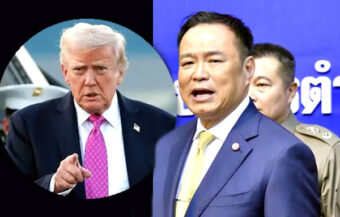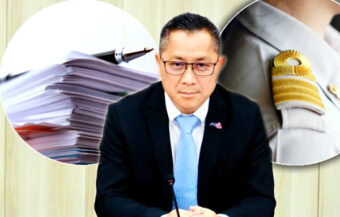Thailand faces a growing economic crisis as credit dries up, exports rely on Chinese goods and tourism declines. With GDP at risk of falling below 1% and a US tariff hike looming, an urgent US trade deal and stimulus measures are vital to avoid recession.
Despite narrowly averting a political crisis on Thursday, Prime Minister Paetongtarn Shinawatra’s government faces an overstretched and cash-strapped economy struggling to grow. On Friday, Thailand will submit its formal trade proposal to the Office of the US Trade Representative (USTR). Officials at the Ministry of Commerce are hopeful for a favourable deal with the United States. However, the Economic Intelligence Centre (EIC) of Siam Commercial Bank warns that GDP growth in 2025 could fall below 1% if an agreement is not reached. Coupled with a decline in foreign tourism and ongoing credit tightening, the kingdom’s economy is rapidly approaching a liquidity crisis.

Prime Minister Paetongtarn Shinawatra took decisive steps on Thursday to stabilize the government and the economy. The kingdom is currently facing severe challenges, including an economic crisis and tensions along its borders. These issues persist despite record export figures reported for the first five months of 2025.
According to the Ministry of Commerce, exports increased by 14.9% year-on-year, reaching approximately $138.2 billion during this period. However, a significant portion of these exports are goods shipped from China through Thailand, known as “zero-dollar exports.” This practice inflates official export statistics but does not reflect genuine economic activity within Thailand.
Simultaneously, the domestic market is flooded with cheap Chinese imports, putting local businesses under pressure. Imports have risen across multiple sectors, driven largely by Chinese-controlled companies that repatriate profits back to China. This results in economic gains flowing out of Thailand rather than supporting the local economy.
Thailand’s export growth is boosted by Chinese goods that inflate statistics but harm local businesses and economy
Furthermore, the country faces a credit crunch. Banks are reducing loan advances due to a rise in non-performing loans. This tighter credit environment dampens consumer confidence and reduces spending power. Both households and businesses feel the effects, limiting economic recovery.
Thailand’s trade relationship with the United States has become increasingly critical. The country plans to submit its formal trade proposal to the US on Friday, in response to requests from the Office of the US Trade Representative (USTR). The proposal addresses five key areas: tariff measures and quotas, non-tariff barriers, digital trade management, rules of origin and economic and national security.
The deadline is pressing. The current 90-day suspension on US tariffs expires on July 9. If no agreement is reached, tariffs on Thai goods could rise from 10% to 36%. Despite this, officials remain cautiously optimistic. Thailand previously submitted a framework suggesting tariff reductions on select items, along with plans to ease non-tariff barriers.
Thailand submits trade proposal to the US as looming tariff deadline threatens sharp increase in exports
At the same time, the Ministry of Commerce, led by Pichai Naripthaphan, has intensified efforts to combat substandard imports and fraudulent business practices. The Department of Business Development (DBD) is collaborating with the Anti-Money Laundering Office (AMLO) to target companies using nominee shareholders to circumvent regulations. Penalties now include asset seizures.
However, economic data remains concerning. The Economic Intelligence Centre (EIC) of Siam Commercial Bank projects Thailand may enter a technical recession by the end of 2025. Their forecast for GDP growth is 1.5% for 2025, contingent on successful US trade negotiations. Without a deal, growth could fall to 0.8%.
Three main factors contribute to this slowdown. First, the trade war and global uncertainty are expected to slow export growth in the second half of 2025. Despite a strong first half, overall exports for the year may be flat or slightly negative. Second, the tourism sector is weakening. Foreign tourist arrivals dropped by approximately 3% from January to May compared to last year, mainly due to fewer Chinese tourists and cautious global spending.
Recession risk rises as exports stall, tourism weakens and economic growth depends on US trade deal success
Third, household and business debt problems persist. Banks remain cautious about lending due to increasing non-performing loans. Consumer spending stays weak. Labour market data shows signs of strain. Official unemployment is low at 0.9%, but social security system figures show a rise to 2%, especially in the industrial sector.
Real incomes for Thai workers are below pre-pandemic levels when adjusted for inflation and living costs. Overtime pay and bonuses have declined, reducing household purchasing power. This fragility affects domestic demand and overall economic health.
The impact of US tariffs on Thailand’s GDP is estimated at 1.5% in the baseline scenario. Negotiators aim to reduce the proposed 36% tariff by half. Failure to reduce tariffs would limit GDP growth to 0.8%. Geopolitical risks, such as the Israel-Iran conflict, add further uncertainty.
The government has adjusted fiscal policy to meet these challenges. A ฿157-billion stimulus plan was shifted from digital wallet handouts to investments in infrastructure, tourism, and trade war mitigation. Experts expect this approach to inject funds more effectively into the economy, although the stimulus alone is insufficient for a full recovery.
Household debt and inflation weaken demand while government stimulus targets infrastructure expansion
The 2026 budget, after essential expenses, will decline by 2.2% compared to 2025. Public debt limits constrain additional borrowing. To raise the debt ceiling, the government must implement fiscal reforms to preserve the country’s credit rating. Officials report ongoing work in this area.
Monetary policy is also adjusting. The Bank of Thailand is expected to cut interest rates twice this year, potentially lowering the policy rate to 1.25% by year-end and to 1.0% by the end of 2026. These cuts aim to support growth and ease credit constraints.
Business confidence remains critical. Efforts to increase credit flow involve reducing lending risks through government-backed guarantees. Additionally, diversifying economic activities, including exploring wellness tourism, may provide new growth avenues.
Political stability affects economic confidence. Uncertainty in government policy reduces trust among investors and consumers. Analysts note that maintaining democratic processes helps manage this risk. Quick resolution of political issues, such as the cabinet reshuffle, would help restore confidence.
Changes to fiscal and monetary policy while political stability is key to investor and consumer confidence
On the ground, businesses are under severe pressure. The construction industry reports the worst conditions in 15 years. Both government and private construction projects have declined sharply, and banks are reluctant to lend. This has forced many contractors to abandon projects or close operations.
Rising material costs exacerbate the problem. Steel prices increased by 10-12%, and shortages followed the collapse of a government building that halted steel production. Contractors are urging the government to provide soft loans to ease liquidity issues. They also request contract prices to be adjusted to reflect increased labour and material costs.
Delayed payments from government agencies further strain cash flow. The Comptroller General’s Department has been asked to expedite payments totalling ฿3,000 to ฿4,000 million baht. The Thai Contractors Association emphasizes the urgency of government intervention to prevent further business closures and job losses.
Construction faces worst downturn in 15 years amid rising costs, liquidity shortages and delayed payments
Export values surged in May, driven by a rush to ship goods ahead of the possible tariff hike. May exports rose 18.4% year-on-year to a record $31 billion. Shipments to the US increased by 35%. However, the Thai Chamber of Commerce predicts June exports will decline as tariff uncertainty persists.
In the first five months of 2025, imports grew 11.3%, reaching approximately $139.3 billion, resulting in a trade deficit of about $1.2 billion. This deficit reflects ongoing challenges in balancing trade amid global economic uncertainties.
Notably, a large proportion of this rise was linked to goods imported from China.
In conclusion, Thailand faces significant economic challenges despite some positive export statistics. The true state of the economy is weakened by inflated export figures, credit constraints and deflationary pressures. The success of upcoming trade negotiations with the US will be crucial to preventing a recession and maintaining growth.
Talks with the United States to begin but Thailand is hopeful of an extension to the July 8th deadline
Economic engine sputtering as chronic, intractable problems stall growth and reduce purchasing power
Government actions, including trade reform, fiscal stimulus and tighter regulation of imports and business practices, are ongoing. However, multiple sectors, especially construction, face critical liquidity problems that require immediate attention. The next few months will be pivotal for Thailand’s 2025 performance.
For now, the outlook is negative with hampered export prospects and a downturn in foreign tourism since February 2025 which has not reversed itself.
Join the Thai News forum, follow Thai Examiner on Facebook here
Receive all our stories as they come out on Telegram here
Follow Thai Examiner here
Further reading:
Thai Minsters engage with US trade chief Jamieson Greer in Paris at global OECD ministerial meeting
Commerce Minister meets US trade boss Jamieson Greer in Korea. Paul Chambers case still dogs talks


















